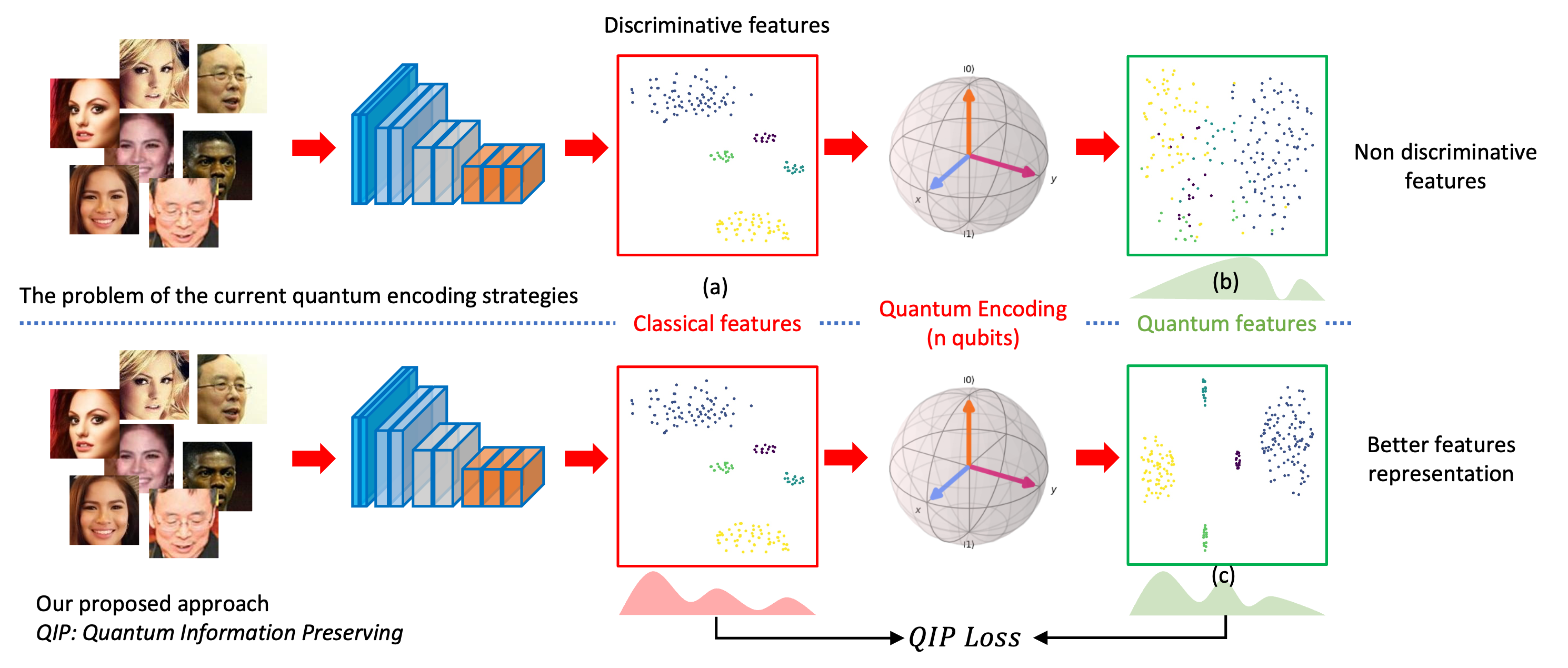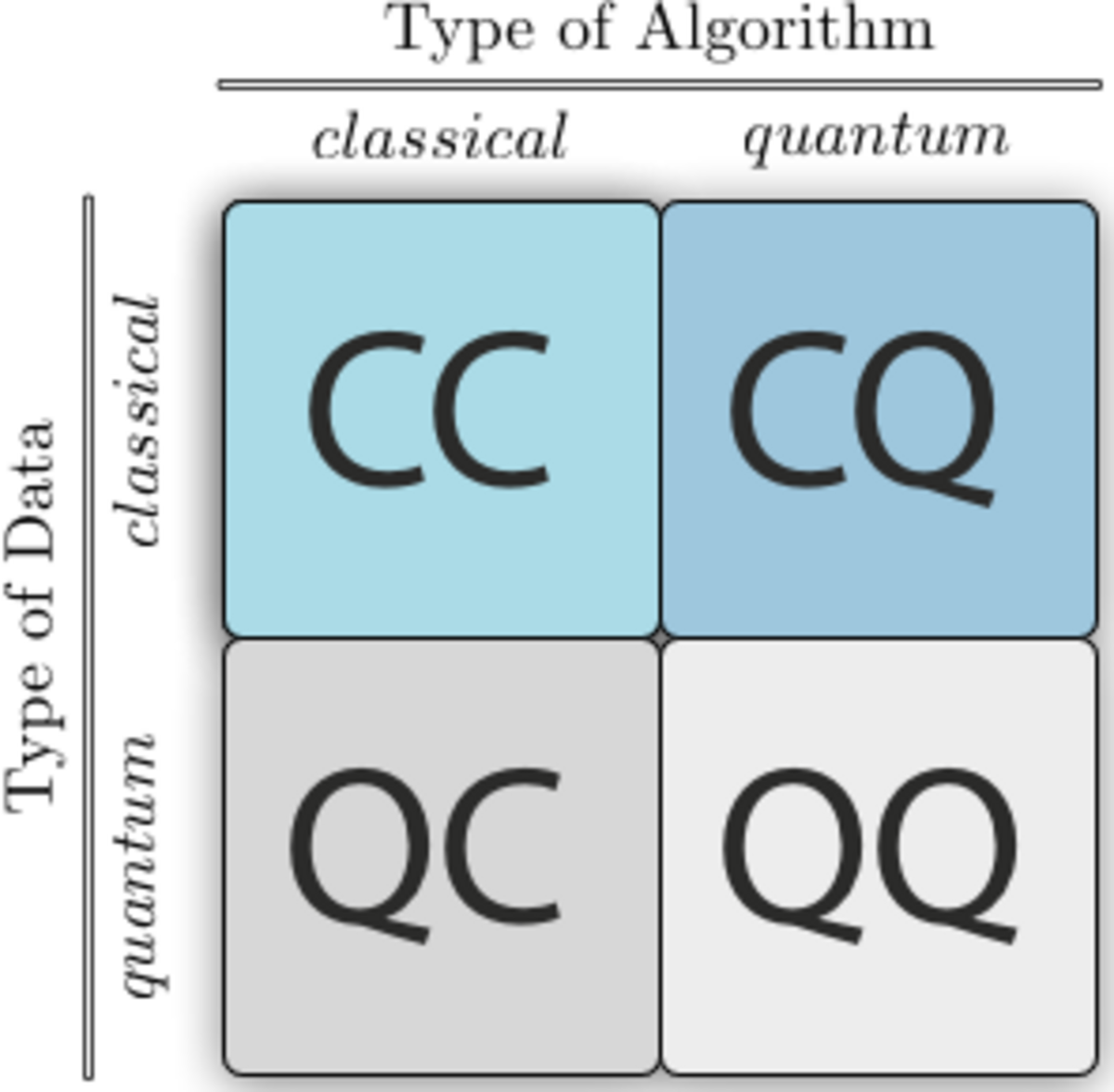Quantum Visual Feature Encoding Revisited
2405.19725

0
0

Abstract
Although quantum machine learning has been introduced for a while, its applications in computer vision are still limited. This paper, therefore, revisits the quantum visual encoding strategies, the initial step in quantum machine learning. Investigating the root cause, we uncover that the existing quantum encoding design fails to ensure information preservation of the visual features after the encoding process, thus complicating the learning process of the quantum machine learning models. In particular, the problem, termed Quantum Information Gap (QIG), leads to a gap of information between classical and corresponding quantum features. We provide theoretical proof and practical demonstrations of that found and underscore the significance of QIG, as it directly impacts the performance of quantum machine learning algorithms. To tackle this challenge, we introduce a simple but efficient new loss function named Quantum Information Preserving (QIP) to minimize this gap, resulting in enhanced performance of quantum machine learning algorithms. Extensive experiments validate the effectiveness of our approach, showcasing superior performance compared to current methodologies and consistently achieving state-of-the-art results in quantum modeling.
Create account to get full access
Overview
- Explores a novel approach to quantum-enhanced computer vision using a quantum visual feature encoding method
- Presents a theoretical framework and experimental results for effectively encoding visual features in a quantum state
- Demonstrates the potential of quantum computing to enhance machine learning tasks in computer vision
Plain English Explanation
This paper investigates a new technique for using quantum computing to improve computer vision tasks. The key idea is to encode visual features, like the shapes and textures in an image, into a quantum state. This quantum representation of the visual information can then be processed using quantum algorithms, potentially offering advantages over classical approaches.
The researchers develop a theoretical framework for this <a href="https://aimodels.fyi/papers/arxiv/exploring-quantum-enhanced-machine-learning-computer-vision">quantum visual feature encoding</a> method and provide experimental results showing its effectiveness. They demonstrate that by mapping visual features into a quantum state, it is possible to perform certain machine learning operations more efficiently on a quantum computer compared to a classical computer.
This research suggests that <a href="https://aimodels.fyi/papers/arxiv/feature-importance-explainability-quantum-machine-learning">quantum machine learning</a> techniques could be a promising avenue for enhancing computer vision systems, potentially leading to faster, more accurate, and more efficient vision-based AI applications in the future.
Technical Explanation
The paper presents a novel approach to <a href="https://aimodels.fyi/papers/arxiv/independent-implementation-quantum-machine-learning-algorithms-qiskit">quantum machine learning for computer vision</a> called "quantum visual feature encoding." The key idea is to map visual features, such as shapes, textures, and other characteristics of an image, into a quantum state. This quantum representation can then be processed using specialized quantum algorithms.
The researchers develop a theoretical framework for this encoding process, which involves defining a set of basis states that correspond to different visual features. They then show how to prepare a quantum state that encodes the relevant visual information from an input image. This encoded quantum state can then be used as input to various quantum machine learning algorithms, potentially offering advantages over classical approaches.
The paper includes experimental results demonstrating the effectiveness of this quantum visual feature encoding method. The experiments show that by mapping visual data into a quantum state, certain machine learning tasks, such as <a href="https://aimodels.fyi/papers/arxiv/qubit-efficient-variational-quantum-algorithms-image-segmentation">image segmentation</a>, can be performed more efficiently on a quantum computer compared to a classical computer.
Critical Analysis
The paper presents a compelling theoretical framework and experimental results for quantum-enhanced computer vision, but there are a few caveats to consider. First, the experiments were conducted on relatively simple image datasets, and it's unclear how well the quantum visual feature encoding method would scale to more complex, real-world computer vision tasks.
Additionally, the paper does not address the practical challenges of implementing these quantum techniques on current quantum hardware, which is still relatively noisy and limited in its capabilities. Achieving a meaningful quantum advantage for computer vision applications may require significant advancements in <a href="https://aimodels.fyi/papers/arxiv/quantum-machine-learning-hqc-architectures-using-non">quantum hardware and algorithms</a>.
Overall, this research represents an important step forward in exploring the potential of quantum computing to enhance machine learning in the domain of computer vision. However, further research and technological progress will be needed to fully realize the benefits of this quantum-enhanced approach.
Conclusion
This paper presents a novel technique called "quantum visual feature encoding" that aims to leverage quantum computing to improve computer vision tasks. By encoding visual features into a quantum state, the researchers demonstrate the potential for quantum algorithms to outperform classical approaches on certain machine learning problems.
The theoretical framework and experimental results outlined in this paper suggest that <a href="https://aimodels.fyi/papers/arxiv/exploring-quantum-enhanced-machine-learning-computer-vision">quantum-enhanced computer vision</a> could be a promising area for future research and development. As quantum hardware and algorithms continue to advance, this work highlights the exciting possibility of using quantum computing to enhance the capabilities of AI systems in the field of computer vision, with potential applications in areas such as image recognition, object detection, and scene understanding.
This summary was produced with help from an AI and may contain inaccuracies - check out the links to read the original source documents!
Related Papers

Quantum Generative Learning for High-Resolution Medical Image Generation
Amena Khatun, Kubra Yeter Aydeniz, Yaakov S. Weinstein, Muhammad Usman

0
0
Integration of quantum computing in generative machine learning models has the potential to offer benefits such as training speed-up and superior feature extraction. However, the existing quantum generative adversarial networks (QGANs) fail to generate high-quality images due to their patch-based, pixel-wise learning approaches. These methods capture only local details, ignoring the global structure and semantic information of images. In this work, we address these challenges by proposing a quantum image generative learning (QIGL) approach for high-quality medical image generation. Our proposed quantum generator leverages variational quantum circuit approach addressing scalability issues by extracting principal components from the images instead of dividing them into patches. Additionally, we integrate the Wasserstein distance within the QIGL framework to generate a diverse set of medical samples. Through a systematic set of simulations on X-ray images from knee osteoarthritis and medical MNIST datasets, our model demonstrates superior performance, achieving the lowest Fr'echet Inception Distance (FID) scores compared to its classical counterpart and advanced QGAN models reported in the literature.
6/21/2024
🏷️
Exploring Quantum-Enhanced Machine Learning for Computer Vision: Applications and Insights on Noisy Intermediate-Scale Quantum Devices
Purnachandra Mandadapu

0
0
As medium-scale quantum computers progress, the application of quantum algorithms across diverse fields like simulating physical systems, chemistry, optimization, and cryptography becomes more prevalent. However, these quantum computers, known as Noisy Intermediate Scale Quantum (NISQ), are susceptible to noise, prompting the search for applications that can capitalize on quantum advantage without extensive error correction procedures. Since, Machine Learning (ML), particularly Deep Learning (DL), faces challenges due to resource-intensive training and algorithmic opacity. Therefore, this study explores the intersection of quantum computing and ML, focusing on computer vision tasks. Specifically, it evaluates the effectiveness of hybrid quantum-classical algorithms, such as the data re-uploading scheme and the patch Generative Adversarial Networks (GAN) model, on small-scale quantum devices. Through practical implementation and testing, the study reveals comparable or superior performance of these algorithms compared to classical counterparts, highlighting the potential of leveraging quantum algorithms in ML tasks.
4/4/2024
🔄
Classical-to-Quantum Transfer Learning Facilitates Machine Learning with Variational Quantum Circuit
Jun Qi, Chao-Han Huck Yang, Pin-Yu Chen, Min-Hsiu Hsieh, Hector Zenil, Jesper Tegner

0
0
While Quantum Machine Learning (QML) is an exciting emerging area, the accuracy of the loss function still needs to be improved by the number of available qubits. Here, we reformulate the QML problem such that the approximation error (representation power) does not depend on the number of qubits. We prove that a classical-to-quantum transfer learning architecture using a Variational Quantum Circuit (VQC) improves the representation and generalization (estimation error) capabilities of the VQC model. We derive analytical bounds for the approximation and estimation error. We show that the architecture of classical-to-quantum transfer learning leverages pre-trained classical generative AI models, making it easier to find the optimal parameters for the VQC in the training stage. To validate our theoretical analysis, we perform experiments on single-dot and double-dot binary classification tasks for charge stability diagrams in semiconductor quantum dots, where the related empirical results support our theoretical findings. Our analytical and empirical results demonstrate the effectiveness of classical-to-quantum transfer learning architecture in realistic tasks. This sets the stage for accelerating QML applications beyond the current limits of available qubits.
6/24/2024

Feature Importance and Explainability in Quantum Machine Learning
Luke Power, Krishnendu Guha

0
0
Many Machine Learning (ML) models are referred to as black box models, providing no real insights into why a prediction is made. Feature importance and explainability are important for increasing transparency and trust in ML models, particularly in settings such as healthcare and finance. With quantum computing's unique capabilities, such as leveraging quantum mechanical phenomena like superposition, which can be combined with ML techniques to create the field of Quantum Machine Learning (QML), and such techniques may be applied to QML models. This article explores feature importance and explainability insights in QML compared to Classical ML models. Utilizing the widely recognized Iris dataset, classical ML algorithms such as SVM and Random Forests, are compared against hybrid quantum counterparts, implemented via IBM's Qiskit platform: the Variational Quantum Classifier (VQC) and Quantum Support Vector Classifier (QSVC). This article aims to provide a comparison of the insights generated in ML by employing permutation and leave one out feature importance methods, alongside ALE (Accumulated Local Effects) and SHAP (SHapley Additive exPlanations) explainers.
5/16/2024